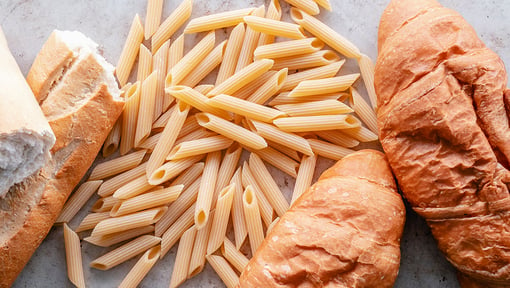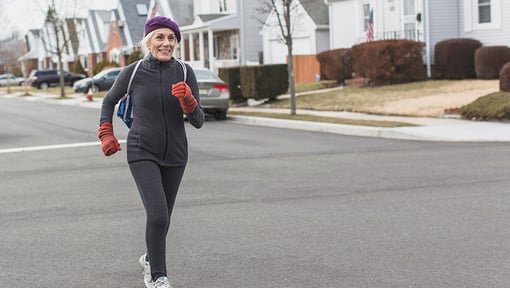It’s tempting to put your feet up and relax after you’ve eaten. But research suggests that a short walk instead can support healthy blood sugar levels.
Think about your post-meal habits. After eating breakfast, do you sit with a cup of coffee and read the news? When you finish lunch, do you scroll through social media or get right back to work at your computer? After dinner winds down, do you head to the couch to watch TV or read?
If that sounds familiar, it might be time to adopt a new habit—a post-meal walk. It can help you fit more steps in each day, which is always a good thing! But it can also help support healthy blood sugar levels.
How eating affects your blood sugar levels
After you eat, your body starts to break down the food you ate to help you digest it. Your digestive system breaks down some foods—like carbohydrates—into glucose. Glucose is another name for sugar. This sugar enters your bloodstream. And thus, after you eat, the amount of glucose—or sugar—in your blood rises.
Some carbohydrates cause your blood sugar to rise more quickly than others do.
Experts devised something called the glycemic index (GI)—and a related scale called the glycemic load (GL)—to rank foods according to how quickly they raise blood sugar. High GI/GL foods cause blood sugar to rise quickly; low GI/GL foods cause blood sugar to rise more slowly. High GI/GL foods include foods like:
- Breads and pastas made from white flour
- Snack foods, like pretzels and chips
- Sugary foods, like cookies, cakes, and breakfast cereals
You can use this online database to search for the GI and GL of many common foods.
 Why spikes in your blood sugar levels can harm your health over time
Why spikes in your blood sugar levels can harm your health over time
It’s best to avoid large spikes in blood sugar, as they can raise your risk of prediabetes and type 2 diabetes. And if you already have diabetes, it can make it harder to manage your condition.
As the sugar in your blood rises, your body releases a hormone called insulin. Insulin helps your cells absorb the sugar in your blood. Your cells can then convert that sugar into energy to use right away, or they can store it and use it later.
If you often eat a lot of foods that raise your blood sugar quickly, you are placing a heavy demand on your body to produce enough insulin. Over time, your body may not be able to make enough insulin to keep up with the demand. And your cells may not be able to use the insulin your body does produce as well as they once did. This is known as insulin resistance.
If these problems occur, your cells won’t be able to absorb the sugar in your blood as effectively. That means your blood sugar levels can remain too high. And in time that can lead to the diabetic condition.
 How walking affects your blood sugar levels
How walking affects your blood sugar levels
The good news is that there’s something quite simple that you can do to help avoid sharp spikes in blood sugar: Go for a short walk after you eat.
Going for a short walk after each meal can help moderate your blood sugar. In fact, research found that walking for as little as 2 minutes after eating can have beneficial effects on your blood sugar levels.
As you walk, your muscle cells spring into action, using oxygen to convert some of the glucose in your blood into energy to help you move. That helps lower the amount of sugar in your blood. If you start moving your muscles shortly after eating—when your blood sugar is highest—it can help to lower your blood sugar levels right away. For best results, go for a walk within 60 to 90 minutes of eating your meal.
Building your muscle mass can also help support healthy blood sugar levels. Click here to learn more.
 How to fit in a post-meal walk
How to fit in a post-meal walk
Here are a few ideas for how you can fit in a post-meal walk:
- After breakfast: You may be able to combine a short walk with some other morning activities. For instance, you could take your dog for a short walk or walk to do nearby errands. Or walk just for the sake of walking.
- After lunch: Build a short walk into your lunch break. If you eat out, walk to and from the restaurant, when possible, instead of driving your car. Ask a friend to join you, if you’d like some company.
- After dinner: If you eat early, take an after-dinner sunset stroll with a partner or neighbor. Or, if it’s too dark or cold after you’ve finished dinner, try walking around indoors.

Other ways to get moving after a meal
Any activity that engages your muscles can have the same helpful effect on your blood sugar levels as walking. The trick is to just get moving—as opposed to sitting or lying on the couch.
For many people, walking is a great choice. It’s low-impact and low-intensity. Plus, it’s often very easy to fit it into your day. But if you’re not able to walk or walking doesn’t appeal to you, find something that better suits you.
Here are a few ideas:
- March in place
- Dance to music
- Lift some weights or use resistance bands
- Walk up and down a flight of stairs a few times
- Do a few bodyweight exercises, like squats, pushups, and lunges
You don’t have to do a full workout or do anything with high intensity. The goal is just to move your body for a brief period of time after eating.
More low-key types of movement, such as light housework, can also do the trick. Even standing can help a bit, though not as much. Here are a few non-exercise ideas to get you moving:
- Clean up the kitchen
- Tidy up a room in your home
- Take out the trash and recycling
- Fold and put away some laundry
Moving more and sitting less is a good goal to have for other reasons, as well.
 Other ways to help support healthy blood sugar levels
Other ways to help support healthy blood sugar levels
Of course, another great way to help avoid sharp spikes in blood sugar is to watch what you eat. Try to avoid eating too many high GI foods—which tend to be highly processed carbs that are high in added sugars. Opt for carbs that are less processed, like whole grains, legumes, and high-fiber fresh fruits and vegetables. These foods don’t raise your blood sugar as much or as quickly, so they can help support healthy blood sugar levels.
Maintaining a healthy weight is also a great way to maintain healthy blood sugar levels. Eating healthy and getting regular exercise can help you manage your weight.
Speaking of regular exercise, there are free, daily workouts available to the public on Facebook Live and YouTube, where you can enjoy a variety of classes suited for all fitness levels. And Silver&Fit® members can access thousands of additional workout videos available anytime on SilverandFit.com.
Going for a walk or getting active in some way after you eat is an easy way to support healthy blood sugar levels. Plus, it helps you meet your fitness goals. This is great news for those who have prediabetes or diabetes. But everyone can benefit.
Check out this clever way to walk and help the environment at the same time.
Not a Silver&Fit® member? Learn more about everything the program has to offer, including more helpful healthy living tips like this, here on our website.
This information is not intended to take the place of regular medical care or advice. Please check with your doctor before using this information or beginning any self-care program. Images used for this article do not depict any members of the Silver&Fit Program.
References
Atkinson, F. S., Brand-Miller, J. C., Foster-Powell, K., Buyken, A. E., & Goletzke, J. (2021, November 8). International tables of glycemic index and glycemic load values 2021: A systematic review. The American Journal of Clinical Nutrition, 114(5), 1625-1632. https://doi.org/10.1093/ajcn/nqab233
Buffey, A. J., Herring, M. P., Langley, C. K., Donnelly, A. E., & Carson, B. P. (2022, August). The acute effects of interrupting prolonged sitting time in adults with standing and light-intensity walking on biomarkers of cardiometabolic health in adults: A systematic review and meta-analysis. Sports Medicine, 52(8), 1765-1787. https://doi.org/10.1007/s40279-022-01649-4
Cleveland Clinic. (2024, November 21). Insulin resistance. https://my.clevelandclinic.org/health/diseases/22206-insulin-resistance
Ellis, E. (2024, September 17). What is glycemic index? Academy of Nutrition and Diatetics. https://www.eatright.org/food/nutrition/dietary-guidelines-and-myplate/what-is-glycemic-index
Endocrine Society. (2022, January 24). Diabetes and endocrine function. https://www.endocrine.org/patient-engagement/endocrine-library/diabetes-and-endocrine-function#:~:text=Diabetes%20occurs%20when%20the%20pancreas,or%20stored%20for%20the%20future.
Harvard Health Publishing. (2023, August 22). The lowdown on glycemic index and glycemic load. https://www.health.harvard.edu/diseases-and-conditions/the-lowdown-on-glycemic-index-and-glycemic-load
Harvard T. H. Chan School of Public Health. (n.d.). Carbohydrates and blood sugar.
http 27s://www.hsph.harvard.edu/nutritionsource/carbohydrates/carbohydrates-and-blood-sugar/#:~:text=When%20people%20eat%20a%20food,sugar%20for%20energy%20or%20storage
Mayo Clinic. (2025, February). Type 2 diabetes. https://www.mayoclinic.org/diseases-conditions/type-2-diabetes/symptoms-causes/syc-20351193
National Institute of Diabetes and Digestive and Kidney Diseases. (n.d.). Diabetes overview. https://www.niddk.nih.gov/health-information/diabetes/overview
Reynolds, A. N., Mann, J. I., Williams, S., & Venn, B. J. (2016, December). Advice to walk after meals is more effective for lowering postprandial glycaemia in type 2 diabetes mellitus than advice that does not specify timing: A randomised crossover study. Diabetologia, 59(12), 2572-2578. https://doi.org/10.1007/s00125-016-4085-2
Smith, A. D., Crippa, A., Woodcock, J., & Brage, S. (2016, December). Physical activity and incident type 2 diabetes mellitus: A systematic review and dose-response meta-analysis of prospective cohort studies. Diabetologia, 59(12), 2527-2545. https://doi.org/10.1007/s00125-016-4079-0
This article was written by Nora Byrne, edited by Candace Hodges, and clinically reviewed by Jaynie Bjornaraa, PhD, MPH, PT, LAT, ATC, CSCS, CSPS, on July 28, 2025.





